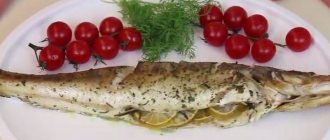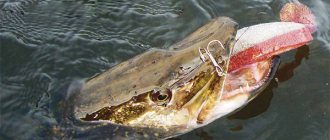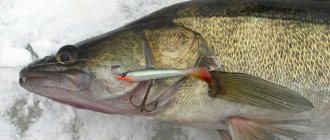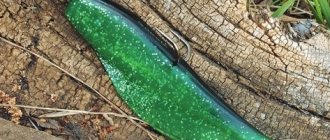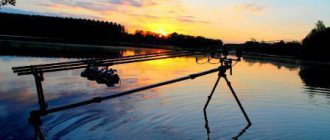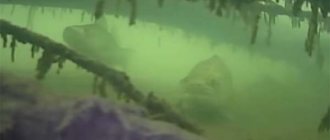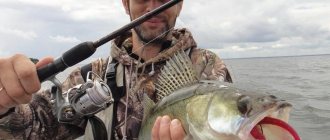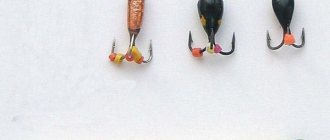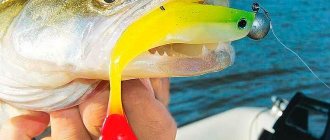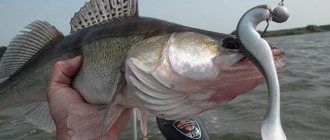Silicone baits for pike perch no longer surprise our domestic fisherman with their variety of shapes, colors and even tastes. Today, bait of this type is more of a mandatory attribute of spinning fishing than a curiosity and a scarce product, as it was a couple of decades ago. The low cost of silicone and the realistic way it conveys the movements of a fry or other natural food item of a predator have brought simulators to the leading position of use, and fishing for pike perch with an elastic band has become the most popular method of hunting.
The huge selection of products also entails a number of difficulties in selecting the most effective baits for certain fishing conditions and the mood of the pike perch. After all, as often happens, there is practically no place for versatility in fishing, and this statement is directly related to the selection of silicone that is promising for catching fanged fish.
The purpose of the article is to acquaint the reader with the varieties of pike perch silicone baits that can increase the number of effective bites, as well as for the spinning angler to understand the methods of forming a spinning rig. In addition, we will present a rating of the most popular and effective silicones in practice, from which you can form your initial pikeperch arsenal.
What are silicone baits
Silicone bait for pike perch is a soft rubber product of a certain shape and color. The capricious and predatory pike perch goes well with edible rubber impregnated with a flavoring agent.
Silicone bait:
- attracts to itself with a smell, gives off fish oil, attractant (flavor impregnation);
- becomes attractive to fish, because they do not differ in taste and smell from natural food items;
- begins to release the aroma of natural prey when it enters the mouth, increasing the time it takes to hold the fish until it recognizes the deception.
Catching pike perch with a rubber band has become the most popular method among many spinning anglers. Silicone bait shows excellent results on water in winter and summer. Even during its period of passivity, the predator begins to rush to the smell of shrimp and fish. For a fisherman, this is an excellent opportunity to get a big trophy. Bites will follow one after another if the movement of the rubber fry does not differ from the natural food object for the predator.
Key varieties
A large number of silicone baits from the “edible rubber” category are sold on the market, but according to the principle of operation they are divided into two large groups:
- Floating.
- Drowning.
The first option is not as common as the second and is produced by only a few brands. Floating vibrotails and twisters are in demand when pike perch is in the lower water horizon, when it pounces on prey located at the bottom. When the rig with the artificial fish goes down, the latter stops in a vertical position, giving the fish the opportunity to study the prey and take decisive action. After this, the chase and frisky bite begin.
Floating rubber is also effective when using Moscow equipment, when the wiring provides for long pauses. It is during these pauses that a large number of bites occur.
Sinking models are ubiquitous and feature a wide selection of shapes, sizes and colors. In many conditions, they are the only non-alternative solution that gives excellent results. The main thing is to choose the right bait, guided by the characteristics of the reservoir, the food supply of pike perch, water transparency, weather and a host of other factors.
Shape and size of silicone baits for pike perch
When choosing the shape of silicone baits for pike perch, you should take into account the anatomical structure of the fish’s pharynx. The best options are small, elongated, imitating larvae or aquatic insects (slugs, crayfish, worms).
Most of all, pike perch is responsive to vibrating tails, slugs, and twisters. Although, with proper wiring, worms, larvae, and crayfish will also be used.
Optimal bait sizes for catching predators:
- length – 2.5-4 inches (20-50 mm);
- thickness or diameter – 10-15 mm.
Reference!
You should not choose bait that is too bulky to catch pike perch. If the reservoir for catching pike perch is unfamiliar and you have to select a bait taking into account the situation, then the optimal length will be 3 inches. If the pike perch is large, then you can increase the size of the bait to 5-6 inches. That is why experts advise taking several varieties of narrow-bodied and wicking silicone baits with you when fishing. You can start the raid with a large bait. If bites become uncertain and fish activity decreases, then you can switch to smaller baits.
Taking into account the anatomical structure of the mouth, the pike perch perfectly swallows small prey with a narrow body. This means that the size of the nozzles should be small to serve food in small portions.
Spoons
The effectiveness of spinners is significantly lower than that of wobblers and silicone baits, however, towards the end of the summer, when the pike perch becomes significantly more active, experienced fishermen begin to use large spinners.
Kastmaster
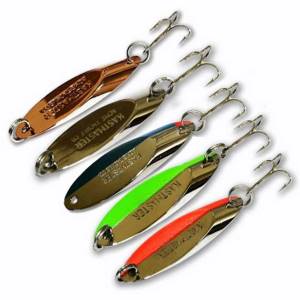
A universal oscillating spoon, having the shape of a cylinder cut at an angle, is used on:
- uniform wiring;
- stepped;
- jig (with toss).
As it falls, the Kastmaster begins to oscillate, and it is at this moment that the fish grabs the spoon. The optimal castmaster size is 5-6 cm, and the weight is 10-21 g, and the larger the water area, the heavier the spinner should be. To reduce the number of hooks, doubles are installed.
Mepps Lusox
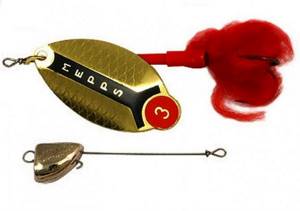
Lusox is one of the most catchy large heavy deep-sea spinners. It moves almost along the very bottom and has a game even more lively and active than a jig.
You may be interested in: Shad wobblers
Mepps Aglia Long No. 3
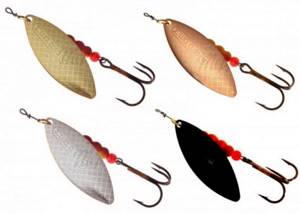
A rotating spoon is highly effective for catching bottom predators, which include pike perch. It works quite well at great depths and in strong currents. The frequency of rotation of the petal allows you to smooth out the mistakes of an inexperienced fisherman when retrieving, which makes Mepps Aglia Long No. 3 the most suitable of all heavy metal baits for beginners.
Oscillator Atom

A heavy oscillating spoon, inexpensive, works great both in summer and winter, even with strong currents and on different retrieves:
- uniform:
- with pauses:
- jig.
The stable game of Spinnex Atom with pronounced low-frequency vibration, reminiscent of the movements of a wounded fish, attracts the attention of a predator from afar. Having encroached on easy prey, he will definitely get hooked.
Color of silicone bait for pike perch
It is difficult for a predator to guess the optimal color of a silicone bait for pike perch. During the period of passivity, bright baits are unlikely to be attractive. If the predator is active and bites well, it will even go for unremarkable silicone baits in dark green shades.
Yellow and bright red baits that imitate the natural color of prey are considered catchable. Although, depending on the terrain and method of fishing, silicone baits for pike perch in brown, light green, green, and purple shades are quite suitable.
Advice!
Even experienced spinning anglers disagree on which color of silicone is preferable for pike perch. If the predator is at depth, it is more focused on the noise and vibration emanating from the rubber imitation. However, it was noted that the fish is quite aware of the color scheme if at the time of the raid it is 3 meters from the shore. Of course, it is difficult to predict the color when going fishing. It is better to take several baits of different colors with you, especially if the area on the pond is completely unfamiliar.
In sunny and clear weather, bait in dull colors will be attractive: dark blue, gray. In cloudy weather, it is better to prefer light, bright colors: yellow, carrot, acidic.
On a note!
Fishing can be quite successful using baits of light green, brown, purple, and green colors. Although, according to fishermen, the best silicone baits for pike perch are natural ones, close to the native inhabitants of the reservoir. In the summer heat, fish are passive, so use the best flavored baits with the smell of fish or shrimp. On cloudy days, brightly colored baits are suitable for attaching to a spinning rod.
Techniques and tactics for catching pike perch
Pike perch is a bottom-dwelling fish, to attract which it is important to tap the sinker on the bottom of the reservoir, and when attacking, make temporary pauses.
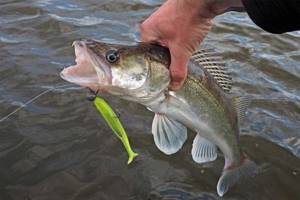
The most effective equipment for fishing with silicone:
- classic (stationary), large bait with a fixed lead head hook. On the water it shows good results;
- hinged with the landing of the sinker and bait on the hook, secured to each other with a carabiner or rings. Silicone moves more freely over a certain distance and, when performing animation actions, becomes a quite catchable bait;
- Carolina with a streamlined sinker, fastened 10-15 cm above the hook. When retrieving, the equipment will periodically come off the bottom, raising a cloud of turbidity that is attractive to predatory fish;
- Texas - an analogue of Carolina, but with the use of a drop-shaped weight and movable attachment to the main cord in order to increase the passability of the equipment in overgrown areas of the reservoir. The main thing is to place the weight with the narrow part towards the rod;
- with a retractable leash - equipment using medium-sized silicone is suitable for catching pike perch from a boat at great depths. The sinker is attached with a swivel to the end of the main cord and slightly above (20 cm) the thin leash.
Reference!
The most popular retrieve among fishermen is jerk fishing, in which the bait rises from the bottom periodically, moving towards the fishing rod at a certain distance and raising a cloud of turbidity. This approach becomes attractive to the predator, especially the combination of the action of silicone dragging along the bottom of the reservoir with a rising cloud of turbidity.
If the area of the water area is snaggy, then it is better to catch pike perch using spaced rigs (Carolina, Texas, with a retractable leash), the maneuverability and cross-country ability of which are higher.
Even if there are snags, the equipment will not be completely lost. If the bottom is clean, then it is better to prefer combined rigs (stop-and-go technique, classic jigging) with temporary pauses.
Twister installation methods
There are several ways to install a twister, each of which has its own pros and cons.
Installing a twister on a jig head
Attaching a twister to a jig head is the most common way to mount this silicone bait. The most universal mounting method, can be used in a wide variety of fishing conditions. The jig head is a hook with a weight rigidly attached to it. The jig head can be in the shape of a bullet, fish head or boot, but the most common shape is a ball.
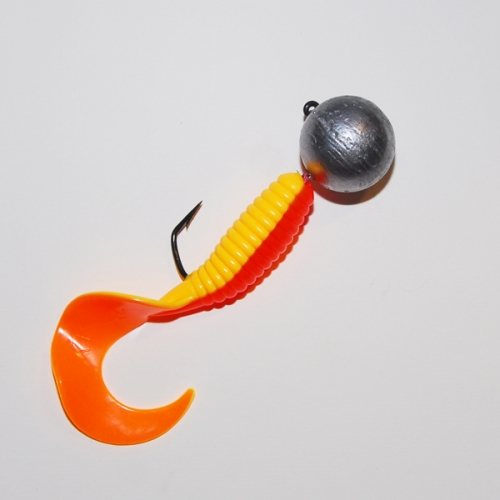
In order to attach a twister to the hook of a jig head, you must first compare their sizes with each other by attaching the hook to the body of the twister. The tip of the hook should come out on the last ribs of the twister, then it will work as it should.
Having remembered the place on the twister where the tip of the hook should come out, stick the hook into the end of the twister, carefully put the twister on it and bring it out in the place of the twister that you outlined at the very beginning. The hook, after installation, should not touch the tail of the twister.
You may be interested in: Owner fishing lines - versatility and quality assurance
Hinged mounting of a twister on an offset hook with a Cheburashka weight
Hinged mounting of a twister on a hook with a Cheburashka weight is one of the best ways to mount this bait. This mounting method gives the bait a maximum degree of freedom, which increases the chances of the bait being attacked by a predator. In addition, this installation method ensures maximum casting range.
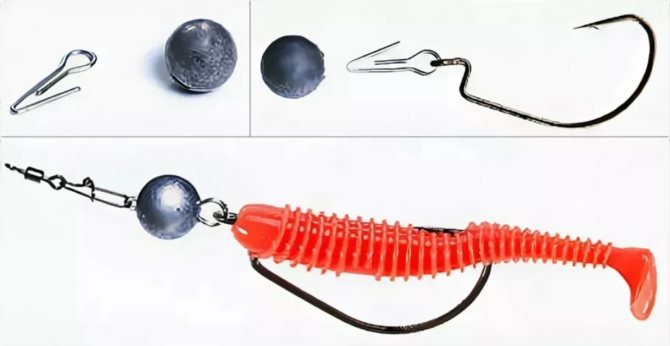
With a hinged installation, the twister can be mounted on a single, double or even triple hook. The hook is attached to the Cheburashka weight, either through a clasp that can be removed from it, or if the weight is not removable, then through a winding ring.
In order to place a twister on a hook, you first need to select a hook of the required length by attaching the twister to it and checking that the sizes match each other.
Insert the tip of the hook into the end of the twister, pass it through the body of the twister, and remove it from the body in a pre-designated place. After this, attach the hook to the weight.
When attaching a hook to a regular non-separable Cheburashka, you should either use two winding rings connected in series, or rotate the eye of the Cheburashka 90 degrees.
Installation of a twister on an offset hook in the form of a non-hook
Fishing with twisters is often carried out in difficult places: in areas with a rocky bottom, in snags, in reservoirs heavily overgrown with underwater vegetation. In such places, in order to avoid a large number of hooks and bait breaks, you should fish with a twister on an offset hook mounted in the form of a non-hooking hook. With this installation option, the tip of the hook is pressed to the body of the twister, and when a predator bites, it is released and digs into its mouth.
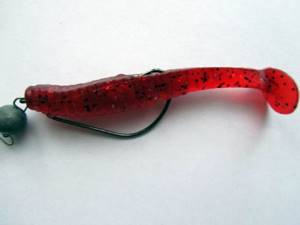
In order to mount the twister on an offset hook in the form of a non-hook, we pierce the end of the twister with the tip of the hook, insert it inside and bend it at a right angle. We stretch the twister to the shank of the hook. We try the twister on the hook and remember the location of the future puncture. We pierce the twister perpendicular to his body. We check the quality of installation of the twister, to do this we run our finger along its body; the finger should not cling to the hook, and with light pressure the body of the twister should sag.
Hinged mounting of a twister on a double with a Cheburashka load
Quite often, the twister is mounted on a double hook with a Cheburashka weight attached to it. There are two ways to mount a twister on a double. The simplest option is when the double is slightly spread apart, a twister is placed on one hook in the usual way, as on a single hook, and the other hook of the double is located outside the twister and acts as a pressure spring. This installation option is simple and allows you to quickly replace the twister on a double if necessary.
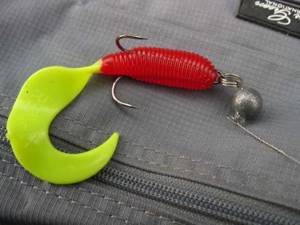
Another option for installing a twister is more complex. The hooks of the double are slightly moved apart, the tip of one hook pierces the twister approximately in the middle of the body of the twister, then the twister is pulled along the fore-end, to the eye of the double. When the eye of the double is in the body of the twister, push it forward of the body of the twister until the eye comes out at the end of the twister. With this installation method, you should use a twister made of durable and elastic silicone, otherwise the twister will break during installation.
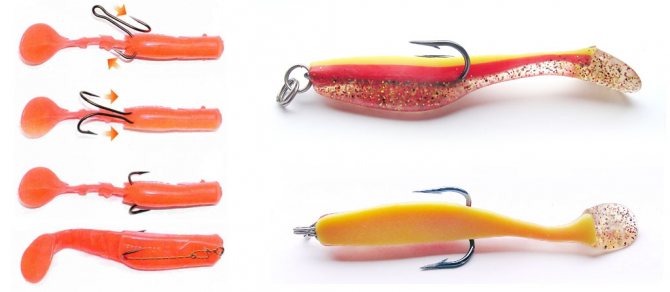
Exploded snap-ins

Recently, a wide variety of spaced-out equipment has become increasingly popular among spinning fishermen. With spaced rigs, the silicone bait attached to the hook and weight are spaced apart from each other. With this installation option, the silicone bait receives more freedom of movement, and the angler can perform a wide variety of wiring. Spaced spinning rigs include: lead leader, drop shot, split shot, Texas and Carolina rigs. With all these and other spaced-apart equipment, you can and should use a twister.
Top 10 silicone baits for pike perch
We will present to your attention a rating of silicone baits for pike perch, which will help beginner spinning anglers navigate the selection and purchase. And so, we will consider the top silicone baits for pike perch in more detail below.
Mann's Predator
Mann's Predator is a brand that produces rubber to get long-awaited bites even when the predator is completely passive. A soft, active silicone bait with a narrow body, slightly compressed from the sides. The tail is active when playing “nickel”, since it is made with threading. If it is the opposite, then the vibrating tail will produce the strongest vibration.
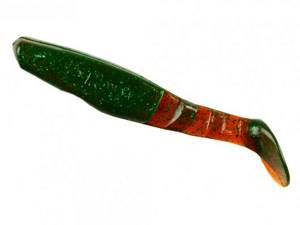
Mann's is a fish or fry simulator - the usual food for pike perch. The running size of silicone bait for pike perch is 2; 2.5; 3 inches. The color palette of vibrotails is wide. Manufacturers offer one-color, two-color, and three-three-color combinations. Bright colors are suitable for catching pike perch in bays and rivers. Natural (pearl, light, white) - for catching in closed lakes and reservoirs.
Lucky John Tioga
Lucky John Tioga vibrating tail is a small fish simulator with uniform wiring.

Tioga is a range of scented baits, different in color and size. The smell of crabs and mackerel emanating from them is excellent for pike perch fishing.
Fanatic Larva
Fanatic Larva is an imitator of dragonfly larvae, so pike perch is unlikely to remain indifferent to the delicacy. The model is equipped with relief ribs and 3 pairs of legs for naturalness. Works flawlessly with hinged mounting, i.e. in tandem with Cheburashka.
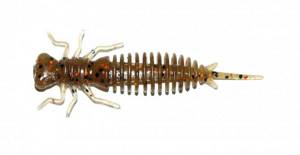
In summer, it is good to use the bait by dragging along the bottom, slightly twitching when catching pike perch. In cold weather, you can do the same wiring, but with pauses of up to 5 seconds.
Manns Twister
Manns Twister is a timeless classic (according to spinners). The twister is equipped with a large tail, has proven impeccable during sweeping play in free fall, and is completely resistant to the teeth of a predator.
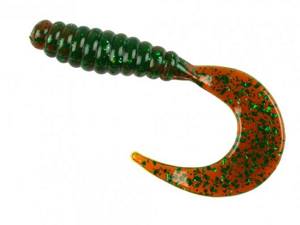
It will also work at low water temperatures due to modern silicone of different colors, which will appeal to even passive fish.
Reins Bubbling Shad
Reins Bubbling Shaker rubber - slug. The pike perch model is catchy, made of soft rubber, impregnated with a large amount of attractant. The body is covered with silicone ribs, slippery and soft to the touch. With intense movement, it emits peculiar vibrations on the water, accompanied by a trail of bubbles.

When wiring between the ribs, air will begin to accumulate and escape as it fills. The pike perch will become interested in this effect and will begin to chase the bait all the way to the shore. The vibrotail has proven its impeccability on jigging and its catchability when installing drop-shots.
Keitech Swing Impact
Keitech Swing Impact tires from Japanese manufacturers, produced under the “Keitech” brand.
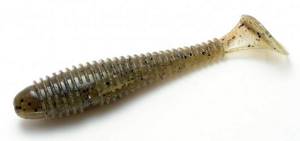
All models are different in elasticity and material density. With their help, every angler will be able to choose the optimal style of playing on the water.
Keitech Sexy Impact
Edible silicone bait Keitech Sexy Impact from Japanese developers, made of elastic silicone of an unusual shape, saturated with attractant. The bait is very similar to the usual food in a reservoir for predators, because... imitates leeches, crawling, earthworms. The body of the edible bait is half round in cross-section with a smooth transition into a thickened section. At the end of the bait there is a thin short tail. The surface is corrugated, imitating the texture of a real leech or worm.

The upper part is made of silicone with low specific gravity. The lower part is heavier, where the highest concentration of salts is collected. This form of bait allows you to take a stable position on the water. Manufacturers offer baits of different colors: light, dark, bright with sparkles, natural with the possibility of use on steep river edges, in stagnant reservoirs.
Keitech Easy Shiner
The Keitech Easy Shiner bait with a flat body and a narrow tail at the end imitates the shape of a real fish, fry, or bleak. Such food for pike perch is soft, salty with the smell of boiled squid.
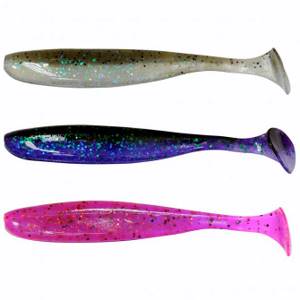
The fish will stay in your mouth for a long time. Also, when installed with an offset hook made of rubber, you can make an excellent non-snagging hook.
{banner_vnutri-kontenta-3}
Relax Copyto
Relax Kopyto is one of the best live, catchable vibrotails for pike perch. It will definitely please spinning anglers with a catch of trophy specimens. The nozzle is universal.
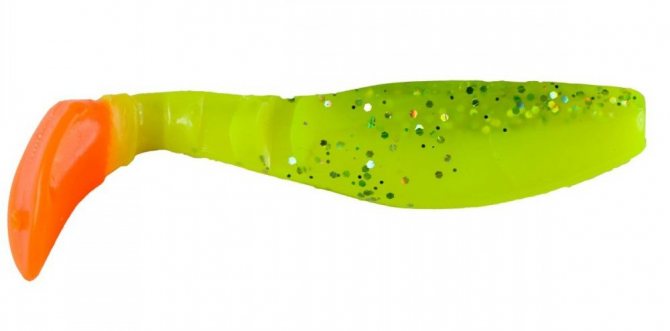
Makes it stable, can be used on pike. It has proven its high catching abilities during natural play on the water.
Sawamura One'up Shad
Japanese brand Sawamura One'up Shad, “pike perch killer” in the slang of experienced spinning fishermen.

Manufacturers offer a whole line of vibrating tails, different in size and color for catching weighty trophies that are active when playing on the water.
Pike perch is a schooling fish, so it begins to feed, and the fisherman needs to continue casting there. The predator is cunning. When catching, it is important to take a responsible approach to choosing not only bait, but also a good body of water. Passive silicone baits for pike perch in the form of aquatic inhabitants (crustaceans, worms) increase the catch of passive pike perch. When a predator does not want to bother chasing bright baits. Active fish will probably start chasing any bait, regardless of color. The main thing is that the silicone is edible and makes oscillatory movements on the water.
Artificial rubber is popular with fishermen because it confuses the pike perch after it bites. While the fish is discussing the edibility of the product, the fisherman cannot yawn. It's worth pulling out a copy. The good thing about catchy silicone baits for pike perch is that even if there are some errors in fishing tactics, novice fishermen can fully count on catching decent trophies.
What is the difference between a twister and a vibrotail
Twisters and vibrotails are two of the most popular types of silicone baits. There are both similarities and differences between these two types of baits.
Both types of baits can be made from edible or regular silicone. The vibrotail has a body shape in the form of a small fish, protruding, slightly flattened on the sides, with a noticeable narrowing towards the tail; in the twister, the body has a cylindrical shape, with a grooved or smooth surface. The twister's tail has the shape of a sickle-shaped, elastic band; the vibrotail's tail has the shape of a hoof, located perpendicular to the axis of the body.
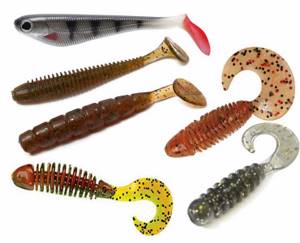
The twister has a higher frequency play, the vibrating tail plays with a lower frequency, but with a larger amplitude.
When fishing for pike and pike-perch, spinners often use vibrating tails, and when fishing for perch, twisters are more often used.
Twisters have better flight characteristics than vibrotails, so they are more convenient when fishing from the shore, in cases where longer casting is required.
Twisters mounted in the form of non-hooking rods are well suited for fishing in places with snags and strong underwater vegetation.
